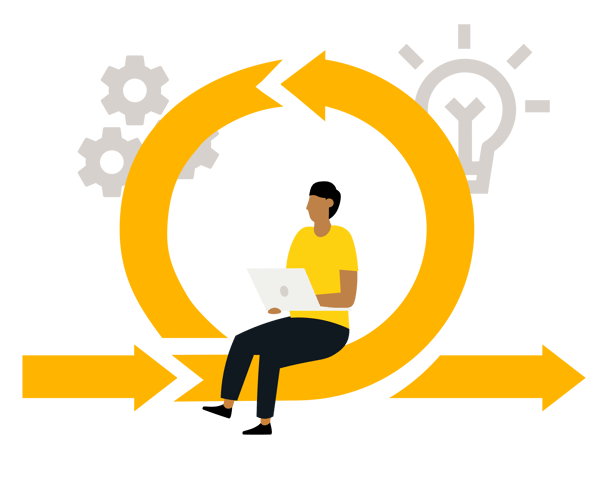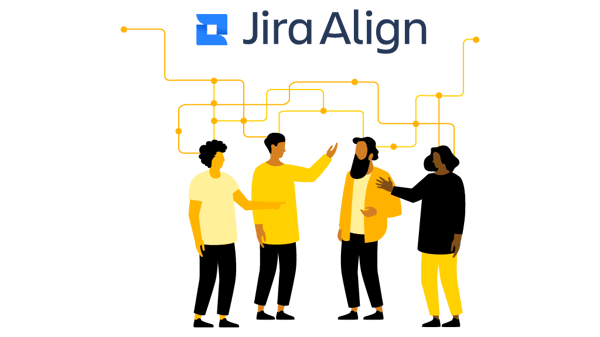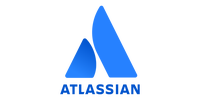Mastering Agile at Scale
Scaling Agility in your organization

Software development teams have proven that implementing Agile frameworks like Scrum and Kanban enables them to deliver faster, more predictable solutions to customers and allows them to react quickly to new information.
Implementing Agile on an individual level is simple. But this approach becomes difficult when multiple teams and enterprise-sized organizations are involved.
Organizations need to be able to adapt at an enterprise scale to stay competitive. The best way to do this is to respond to customers' evolving needs, provide flexible and customizable solutions, support teams working on a unified front, shift mindsets to place technology as a strategic enabler and inspire Agile ways of working outside of software and IT teams.
Listen to this episode of our DevOps Sauna podcast to hear what our experts had to say about scaling Agile.
Part 1
What is Agile at Scale?
When multiple Agile teams work together on the same project/product, the need for effective coordination becomes apparent. While this need doesn’t differ from traditional organizations, the coordination and time needed would be far more intensive.
So what is Agile at Scale? Our definition is about driving Agile at the team level while applying the same sustainable principles, practices, and outcomes at other organizational layers. One Agile at Scale meaning is that it’s a cultural transformation that involves the whole organization (people, practices, tools, etc.), not just R&D.
When implemented correctly, Agile at Scale decentralizes decision-making, creates greater transparency and alignment around work, and increases speed to market—all while keeping true to your organization’s Agile values.
Watch this video to learn six points about Agile from an Agile coach’s perspective and what it should mean to you.
What types of Agility are there to work with?
Organizations can use several methods to improve their performance and stay ahead of the curve when working with Agile. Each has its uses, but these methods are crucial to understanding Agility at Scale for larger enterprises.
Organizational Agility
Organizational Agility refers to an organization’s ability to adapt to changes in internal/external conditions and respond to disruptions, such as adjusting business processes or developing new products. Businesses that have mastered organizational Agility can react quickly to changes in the business environment, which gives them a significant competitive advantage.
Business Agility
Business Agility focuses on improving efficiency and effectiveness in current business operations, which validates the value that has been delivered and identifies new opportunities for creating value.
Enterprise Agility
Enterprise Agility provides an integrated ecosystem to build organizational resilience on multiple levels. It focuses on building resilience and innovation through empowered partnerships and new ways of working that integrate new ideas, theories, and practices with the power of AI.

The importance of Enterprise Agility
Enterprise Agility evolves Agility from a customer-centric view to an enterprise-wide strategic capability, introducing new models that focus on continual reinvention. It balances technology integration and human empowerment (the Science of Accelerated Change) for an integrated approach to transformation.
Enterprise Agility emphasizes activating collective human potential through new Agile leadership principles and scientific models that transform mindsets.
Learn all you need to know about leading an Agile organization below.
Enterprise Agility and SAFe
Enterprise Agility and SAFe are valuable when scaling Agility in large organizations. Here is how SAFe approaches Enterprise Agility:
- SAFe provides a more accepted structure, while Enterprise Agility focuses on creating a mindset across the organization that embraces learning.
- SAFe offers specific roles, events, and flow optimization methods, while Enterprise Agility provides principles and models to transform leadership and culture.
- SAFe orients teams around delivering end-to-end customer solutions, while Enterprise Agility balances customer, company, and workforce well-being.
- While SAFe can deal with product disruption, Enterprise Agility can deal with product and business model disruption.
- SAFe focuses on product development flow, while Enterprise Agility favors adaptable human systems.
Note: While SAFe Agile at Scale is an effective way to approach Enterprise Agility, it may not suit your organization. You should always remember that there are multiple other approaches to scaling Agility—each with its advantages and benefits.
Enterprise Agility and Scrum
Scrum outlines specific roles, events, and practices focused on enabling Agility in software development environments. It provides a structure for faster delivery with transparency and flexibility to adapt to changing customer needs, emphasizing streamlining development workflows alone.
A business looking to come out on top must utilize Scrum and Enterprise Agility to support an Agile enterprise. Now, let’s look at how Business Agility fits into the equation.

The fundamental mindsets of Business Agility
Business first
Only practices that help businesses succeed can build true Business Agility. That’s why your focus should always be on improving value creation.
Control delusion
Plans and estimates are usually incorrect, so a better approach is to find the cause of these faults as soon as possible.
Accumulating complexity
If they’re not determinedly reduced, the complexity of your solutions (and solution creation) will continue to increase.
Decentralized execution is more efficient
Making the right decisions at the right level will make executing your tasks more efficient, provided you follow a common strategy.
Read our blog post on the areas you need to look into to scale better and align your organization’s Business Agility and Agile practices
Key concepts in Business Agility
Manage flow
Focus on value flow management over a portfolio of items.
Work item structure
This defines most value flow, with the groundwork for efficiency defined in work item quality and overall structure.
Fast feedback loops
Learn and adjust in the shortest possible intervals at different levels.
Attention management
Managing an organization’s attention with control cycles ensures the most important items are being taken care of regularly.
Reducing Dependency
Ask yourself if you can redesign your organization and infrastructure/architecture to remove dependencies instead of managing or controlling them.
Learn more about dependency management and visualization in our blog post below.
-square.png?width=600&name=Scaling%20Agility%20Through%20the%20Layers%20of%20Your%20Organization%20(part%201)-square.png)
Part 2
The challenge of complexity
A key tenet of Agile and Agile at Scale is making better decisions about the work that needs to be done and aligning it to changing business needs by actively managing and reducing uncertainty.
This uncertainty results from both internal and external complexities, such as complexities related to internal structures and products or volatile market conditions.
Implementing Agile at Scale involves managing and reducing internal complexity and dependencies.
Create ways to manage complexity
There are many reasons why complexity can’t be easily removed or reduced. But no matter the reason, the need to focus on dependency and value flow management should always follow.
Dependency management provides visibility via your tools, introduces a common planning cycle like SAFe or LeSS, and forms a team of teams to enable its success. On the other hand, Value flow management introduces value mapping, Agile portfolio management, and Agile requirements that focus on work splitting.
NOTE: Instead of telling your teams to create a backlog item for support work to/from other teams, you should consider developing self-service options.
Get rid of complexity
Many organizations neglect to remove complexity, often requiring empowered decision-making units and an adaptable product and technological environment. However, both have their advantages that organizations should consider.
Empowered decision-making units can create delivery-capable organizations, reduce dependencies on functional capability units like marketing, and provide a clear vision and strategy. An adaptable product and technological environment provides a modular technology architecture, a suitable business model, and strong brand guidelines.

Why does (almost) everyone fail to scale Agility?
While Agile has promised competitiveness, time to market, and customer focus for tens of years, it struggles to deliver on these promises in larger organizations. Yes, your teams can be Agile and deliver value fast. But when there are many teams or even business units, Agile doesn’t work.
See our series on the Future of Product to gain insights into how this process could be improved.
Part 3
Approaches for scaling Agility
No matter how your organization approaches scaling Agile, the key point to remember is that the organization's current capabilities and status of team-level Agility always determine how agility should be scaled.
Yes, there are possible options, like SAFe or Less. But the best approach is, more often than not to define the methodology for the company's needs. In the end, what’s more important is understanding the challenges to scaling Agile methods of working.
Read our case study to find out how we implemented SAFe into practice for Samlink.
Business Agility assessments
These assessments help people understand their strengths and weaknesses using constructive feedback from their team members. Business Agility assessments should be used as a development tool for individual leaders and employees, with the combined insights from the feedback process being used to inform an individual’s development plan.
In terms of Agile, a good way to utilize Business Agility assessments is to base your questions around your Scrum values, such as:
- Commitment
- Focus
- Openness
- Respect
- Courage
- Technical Skills
- Domain knowledge
Read our case study to see how we helped Paytrail’s R&D growth through one of these assessments.
PI planning
Program Increment (PI) planning sessions are regularly scheduled events throughout the year where multiple teams meet to align to a shared vision, discuss features, plan the roadmap, and identify cross-team dependencies. They’re at the core of SAFe but used in almost all ways to scale Agility. There are variations of PI planning, such as planning increments or roadmap sharing. Those can be used in environments where there isn't one of a few common products but an organization working with multiple products and deliveries.
Here are the essential elements of PI planning:
- Run every 8-12 weeks (depending on your increment lengths)
- Have your product managers prioritize planned features for the increment beforehand
- Let your developers own user story planning and estimation
- Engineers and UX teams should work to validate the planning
- Align your teams to the mission and each other
- Have everyone involved in planning (not always to attend)
- Utilize technology that allows distributed teams to participate (if needed)
When scaling Agile at the beginning of your journey, common planning sessions, such as PI planning, are a foundation for success.
Read our case study to see how we helped ABB deploy SAFe throughout their entire organization.

Business Agility transformation
Scaling Agility inevitably requires transforming the whole organization, and it’s seen as something that impacts R&D alone. One of the fundamental reasons a transformation effort fails is that organizations can neglect the fact that it will have a much wider scope. The image below illustrates the different facets of an organization where the transformation can have an impact.

When embarking on a transformation journey, you must understand why the effort is being taken in the first place. What is the business reason behind the transformation? Often, organizations need to improve their time-to-market and customer experience, become more cost-effective, and seize new opportunities.
Whatever the business reason for the change, it needs to be solid and well-communicated throughout the organization. This is important since these rationales are more than just words. They’re a force that will provide a solid foundation for the whole change and should be the guiding light to steer the whole transformation process that will impact many parts of the organization.
Understanding different forces of transformation
In the context of an organizational transformation, distinct forces are interdependent, dynamically related, and have varying levels of strength that result from how well these forces are understood, addressed, and aligned. Successful organizational change depends on understanding, addressing, and aligning these forces.
These forces are depicted in the image below:

What, then, is a force in this case? Simply put, a force is an entity that impacts either changing or sustaining the prevailing behaviors within an organization. A force is active since it is realized through human involvement, including motivations, commitment levels, attitudes, learned behaviors, values and beliefs, and past experiences with change or transformation efforts. This nature of a force is what makes it important to understand and manage.
Here are more practical examples of different forces in play during a transformation:

What’s important to realize is that these forces are dynamic and interconnected. To effectively tackle the counterforces, aligning and enabling forces must be carefully adjusted and reflected for the best possible results.
Learn more about business agility and counterforces by reading our guide.

Using Jira Align for scaling
Jira Align is an enterprise Agile solution designed to help organizations connect their teams' work to the business's strategy. With Jira Align, organizations can more accurately plan and deliver work across multiple layers of the enterprise while measuring outcomes that directly result from this work.
This enables organizations to make better decisions about where to invest their resources and track various key metrics that influence these decisions. Jira Align strategic goals, investment, and OKR measurements can all be connected to the incremental planning that occurs across portfolios, programs, and teams. The result is that organizations can use Jira Align to support essential business processes that align teams' efforts and drive customer outcomes together.
Read how Jira Align can be used to enable better portfolio management decision-making.

Scaling Agile practices and facilitating the adoption of Jira Align
When organizations scale their Agile practices, they tend to acknowledge the possibility of some disruption. After all, introducing a new enterprise platform to backscale and synchronize strategies with execution can present additional challenges.
See how we partnered with Demant to overcome these very challenges.
Scaling Agility for remote work
For your business to stay competitive, it needs to adapt constantly. You must respond quickly to customers' changing needs and get your team to work united and goal-oriented.
Without a thorough plan, clear frameworks, and the right methods and tools, you will struggle to scale up your work, manage dependencies between different teams, and focus on the right goals. Many companies invest in Agile methods and tools because they want to change, develop, and bring the organization together.
But with remote work now the norm for many organizations, the need for transparency and clarity has only increased. To this end, your organization must utilize effective and well-configured tools that are easily accessible and transparent (such as Jira Software, Jira Align, and Confluence, which enable collaboration no matter where you are).
Read our blog post to learn more about scaling Agile for remote work in your organization.
Dark Agile
As a collection of anti-patterns at the team and leadership level, Dark Agile describes the mistakes that set the environment and foundation for individuals and teams to succeed or fail in an Agile transformation.
Looking at Scrum Master or Product Owner anti-patterns may be educational, but role-specific insight isolates the situation from the rest of your team and organization. In the Dark Agile module, we look at what causes challenges overall.
In our blog post, you will find out more about Dark Agile and how the mistakes of others can help you in your agile transformation journey.

Part 4
How organizations can help scale Agility
For organizations to successfully apply Agile at Scale, a key understanding and implementation of DevOps is required. DevOps provides the communication, integration, automation, and level of cooperation your organization needs to scale Agility effectively.
While implementing a DevOps transformation in your organization can be done alone, it’s a time-consuming process with many facets. We recommend working with a partner specialized in DevOps transformations (like Eficode) to enable this shift.
Working with experts
Organizations that want to succeed must effectively and efficiently deliver what their customers want. Organizational Agility provides tools, methods, and a mindset for building an organization that will last and grow through changes far into the future. There is no one way to scale Agile, and an extensive understanding of and expertise in Agile development will help you.
Understand your unique needs
Every organization is different, and an expert who understands the importance of your unique context and can consider it will create the best possible scaling approach.
Practical help at different levels
Scaled Agility needs to be anchored at all levels of your organization. Having an expert who offers practical help ranging from individual roles and teams to large-scale processes and working methods can help you focus on leading and steering it.
SAFe, LeSS, and other frameworks
Any organization looking to scale its Agility needs an expert who understands the different Agile at Scale frameworks, such as the Scaled Agile Framework (SAFe) and Large Scale Scrum (LeSS). It also helps if these experts can help you at any point in your change process, such as when selecting the right method or implementing it successfully.

Quality Assurance practices in scaling Agility
With larger organizations choosing SAFe to initiate their digital transformation, how can test managers work in this new frame? What Quality Assurance processes and practices can be applied? What practices can you keep, and what ones should you change? Who will be responsible for what in testing, and how will everything come together?
Find the answer in this talk on a case we were involved in with a large telecom operator working with multiple suppliers and technology vendors who selected SAFe as their business operating system.
Importance of certifications
Given the importance of scaling Agility, working with individuals and organizations that have received certification for implementing Agile at Scale practices is crucial. You’re more likely to succeed in scaling Agility in your organization when you work with experienced people who have planned, executed, and assisted organizations in many transformations.
Below is a selection of Agile at Scale certifications we recommend looking out for:
Scaled Agile Framework (SAFe)
SAFe provides a structured approach for scaling Agile for different levels or organizations. The framework gives your teams a knowledge base that clarifies roles and responsibilities and how to plan and manage work.
Experts with a SAFe certification have:
- The knowledge necessary to lead a Lean-Agile enterprise
- A solid understanding of Lean, systems thinking, Agile development, product development flow, and DevOps
- An understanding of both business and technical Agility and how to organize and reorganize around the flow of value
- The ability to support and execute Program Increment (PI) planning events and coordinate multiple Agile Release Trains (ARTs)
- A more customer-centric mindset and a design thinking approach to Agile product delivery
Scrum
A Scrum Master can lead and inspire your Agile organization towards better ways of working, which can make any team infinitely more effective, focused, disciplined, and harmonious.
Experts with Scrum certification and experience enables them to:
- Excel at coaching colleagues on Agile
- Improve your everyday work by running better team-level Agile ceremonies
- Inspire better team communication and spirit
- Ensure your team is more creative and self-managed

How Eficode can help
As a Scaled Agile partner, we can help you scale Agility in your organization. There is no one way to scale Agile, and our understanding and expertise in Agile development can help you achieve your vision of a future-proof organization. We also work with an organization’s specific needs to ensure that all SAFe and "non-SAFe" implementations are done correctly.
DevOps transformation experts
Eficode specializes in guiding its clients on the journey to DevOps. We’ve overseen DevOps transformations across many industries and can advise on best practices related to culture and deployment pipelines beyond automation.
Award-winning Atlassian partner
As an awarded Atlassian Platinum Solution and Agile at Scale Specialized partner, we are the best place to help you transform your Atlassian Agile at Scale.


